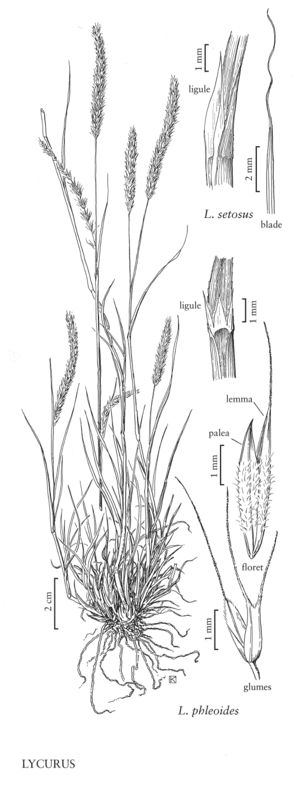Difference between revisions of "Lycurus phleoides"
Common names: Common wolfstail
Treatment appears in FNA Volume 25. Treatment on page 203.
FNA>Volume Importer |
FNA>Volume Importer |
||
| Line 13: | Line 13: | ||
}}<!-- | }}<!-- | ||
| − | --><span class="statement" id="st-undefined" data-properties=""><b>Culms </b>20-50 cm, erect to ascending, often geniculate. <b>Ligules</b> 1.5-3 mm, commonly acute to acuminate, with narrow trianfular lobes 1.5-3(4) mm long extending from the sides of the sheaths; blades 4-8 cm long, 1-1.5 mm wide, acute or mucronate, midribs sometimes extending up to 3 mm as a short bristle. <b>Similar</b> to Lycurus setosus in inflorescence and aspikelet characters, except the upper glumes occasionally with a second shorter, more delicate awn. <b>2n</b> = 40, ca. 40.</span><!-- | + | --><span class="statement" id="st-undefined" data-properties=""><b>Culms </b>20-50 cm, erect to ascending, often geniculate. <b>Ligules</b> 1.5-3 mm, commonly acute to acuminate, with narrow trianfular lobes 1.5-3(4) mm long extending from the sides of the sheaths; blades 4-8 cm long, 1-1.5 mm wide, acute or mucronate, midribs sometimes extending up to 3 mm as a short bristle. <b>Similar</b> to <i>Lycurus setosus</i> in inflorescence and aspikelet characters, except the upper glumes occasionally with a second shorter, more delicate awn. <b>2n</b> = 40, ca. 40.</span><!-- |
-->{{Treatment/Body | -->{{Treatment/Body | ||
|distribution=Maine;Okla.;N.Mex.;Tex.;Ariz.;Colo. | |distribution=Maine;Okla.;N.Mex.;Tex.;Ariz.;Colo. | ||
| − | |discussion=<p>Lycurus phleoides grows on rocky hills and open slopes, at elevations of 670-2600 m. It grows from the southwestern United States to southern Mexico, and in northern South America. It flowers from July-October.</p> | + | |discussion=<p><i>Lycurus phleoides</i> grows on rocky hills and open slopes, at elevations of 670-2600 m. It grows from the southwestern United States to southern Mexico, and in northern South America. It flowers from July-October.</p> |
|tables= | |tables= | ||
|references= | |references= | ||
| Line 38: | Line 38: | ||
|publication year= | |publication year= | ||
|special status= | |special status= | ||
| − | |source xml=https://jpend@bitbucket.org/aafc-mbb/fna-data-curation.git/src/ | + | |source xml=https://jpend@bitbucket.org/aafc-mbb/fna-data-curation.git/src/8f726806613d60c220dc4493de13607dd3150896/coarse_grained_fna_xml/V25/V25_789.xml |
|subfamily=Poaceae subfam. Chloridoideae | |subfamily=Poaceae subfam. Chloridoideae | ||
|tribe=Poaceae tribe Cynodonteae | |tribe=Poaceae tribe Cynodonteae | ||
Revision as of 16:34, 18 September 2019
Culms 20-50 cm, erect to ascending, often geniculate. Ligules 1.5-3 mm, commonly acute to acuminate, with narrow trianfular lobes 1.5-3(4) mm long extending from the sides of the sheaths; blades 4-8 cm long, 1-1.5 mm wide, acute or mucronate, midribs sometimes extending up to 3 mm as a short bristle. Similar to Lycurus setosus in inflorescence and aspikelet characters, except the upper glumes occasionally with a second shorter, more delicate awn. 2n = 40, ca. 40.
Distribution
Maine, Okla., N.Mex., Tex., Ariz., Colo.
Discussion
Lycurus phleoides grows on rocky hills and open slopes, at elevations of 670-2600 m. It grows from the southwestern United States to southern Mexico, and in northern South America. It flowers from July-October.
Selected References
None.
Lower Taxa
None.
